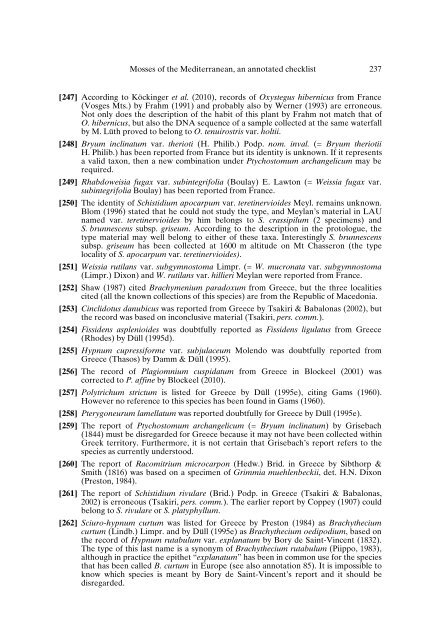Mosses of the Mediterranean, an annotated checklist - Optima-bot.org
Mosses of the Mediterranean, an annotated checklist - Optima-bot.org
Mosses of the Mediterranean, an annotated checklist - Optima-bot.org
You also want an ePaper? Increase the reach of your titles
YUMPU automatically turns print PDFs into web optimized ePapers that Google loves.
<strong>Mosses</strong> <strong>of</strong> <strong>the</strong> <strong>Mediterr<strong>an</strong>e<strong>an</strong></strong>, <strong>an</strong> <strong>an</strong>notated <strong>checklist</strong> 237[247] According to Köckinger et al. (2010), records <strong>of</strong> Oxystegus hibernicus from Fr<strong>an</strong>ce(Vosges Mts.) by Frahm (1991) <strong>an</strong>d probably also by Werner (1993) are erroneous.Not only does <strong>the</strong> description <strong>of</strong> <strong>the</strong> habit <strong>of</strong> this pl<strong>an</strong>t by Frahm not match that <strong>of</strong>O. hibernicus, but also <strong>the</strong> DNA sequence <strong>of</strong> a sample collected at <strong>the</strong> same waterfallby M. Lüth proved to belong to O. tenuirostris var. holtii.[248] Bryum inclinatum var. <strong>the</strong>rioti (H. Philib.) Podp. nom. inval. (= Bryum <strong>the</strong>riotiiH. Philib.) has been reported from Fr<strong>an</strong>ce but its identity is unknown. If it representsa valid taxon, <strong>the</strong>n a new combination under Ptychostomum arch<strong>an</strong>gelicum may berequired.[249] Rhabdoweisia fugax var. subintegrifolia (Boulay) E. Lawton (= Weissia fugax var.subintegrifolia Boulay) has been reported from Fr<strong>an</strong>ce.[250] The identity <strong>of</strong> Schistidium apocarpum var. teretinervioides Meyl. remains unknown.Blom (1996) stated that he could not study <strong>the</strong> type, <strong>an</strong>d Meyl<strong>an</strong>’s material in LAUnamed var. teretinervioides by him belongs to S. crassipilum (2 specimens) <strong>an</strong>dS. brunnescens subsp. griseum. According to <strong>the</strong> description in <strong>the</strong> protologue, <strong>the</strong>type material may well belong to ei<strong>the</strong>r <strong>of</strong> <strong>the</strong>se taxa. Interestingly S. brunnescenssubsp. griseum has been collected at 1600 m altitude on Mt Chasseron (<strong>the</strong> typelocality <strong>of</strong> S. apocarpum var. teretinervioides).[251] Weissia rutil<strong>an</strong>s var. subgymnostoma Limpr. (= W. mucronata var. subgymnostoma(Limpr.) Dixon) <strong>an</strong>d W. rutil<strong>an</strong>s var. hillieri Meyl<strong>an</strong> were reported from Fr<strong>an</strong>ce.[252] Shaw (1987) cited Brachymenium paradoxum from Greece, but <strong>the</strong> three localitiescited (all <strong>the</strong> known collections <strong>of</strong> this species) are from <strong>the</strong> Republic <strong>of</strong> Macedonia.[253] Cinclidotus d<strong>an</strong>ubicus was reported from Greece by Tsakiri & Babalonas (2002), but<strong>the</strong> record was based on inconclusive material (Tsakiri, pers. comm.).[254] Fissidens asplenioides was doubtfully reported as Fissidens ligulatus from Greece(Rhodes) by Düll (1995d).[255] Hypnum cupressiforme var. subjulaceum Molendo was doubtfully reported fromGreece (Thasos) by Damm & Düll (1995).[256] The record <strong>of</strong> Plagiomnium cuspidatum from Greece in Blockeel (2001) wascorrected to P. affine by Blockeel (2010).[257] Polytrichum strictum is listed for Greece by Düll (1995e), citing Gams (1960).However no reference to this species has been found in Gams (1960).[258] Pterygoneurum lamellatum was reported doubtfully for Greece by Düll (1995e).[259] The report <strong>of</strong> Ptychostomum arch<strong>an</strong>gelicum (= Bryum inclinatum) by Grisebach(1844) must be disregarded for Greece because it may not have been collected withinGreek territory. Fur<strong>the</strong>rmore, it is not certain that Grisebach’s report refers to <strong>the</strong>species as currently understood.[260] The report <strong>of</strong> Racomitrium microcarpon (Hedw.) Brid. in Greece by Sibthorp &Smith (1816) was based on a specimen <strong>of</strong> Grimmia muehlenbeckii, det. H.N. Dixon(Preston, 1984).[261] The report <strong>of</strong> Schistidium rivulare (Brid.) Podp. in Greece (Tsakiri & Babalonas,2002) is erroneous (Tsakiri, pers. comm.). The earlier report by Coppey (1907) couldbelong to S. rivulare or S. platyphyllum.[262] Sciuro-hypnum curtum was listed for Greece by Preston (1984) as Brachy<strong>the</strong>ciumcurtum (Lindb.) Limpr. <strong>an</strong>d by Düll (1995e) as Brachy<strong>the</strong>cium oedipodium, based on<strong>the</strong> record <strong>of</strong> Hypnum rutabulum var. expl<strong>an</strong>atum by Bory de Saint-Vincent (1832).The type <strong>of</strong> this last name is a synonym <strong>of</strong> Brachy<strong>the</strong>cium rutabulum (Piippo, 1983),although in practice <strong>the</strong> epi<strong>the</strong>t “expl<strong>an</strong>atum” has been in common use for <strong>the</strong> speciesthat has been called B. curtum in Europe (see also <strong>an</strong>notation 85). It is impossible toknow which species is me<strong>an</strong>t by Bory de Saint-Vincent’s report <strong>an</strong>d it should bedisregarded.






